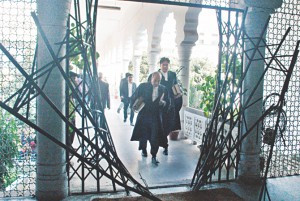Ninth Circuit Rejects Plaintiffs’ “Every Exposure Counts” Theory
By Don Willenburg, Oakland on April 4, 2016
 A Ninth Circuit panel including former Chief Judge Kozinski last week rejected the “every exposure” theory advanced by many plaintiff expert witnesses, who thereby try to impose liability on defendants responsible for only vanishingly small amounts of asbestos.
A Ninth Circuit panel including former Chief Judge Kozinski last week rejected the “every exposure” theory advanced by many plaintiff expert witnesses, who thereby try to impose liability on defendants responsible for only vanishingly small amounts of asbestos.
McIndoe v. Huntington Ingalls Inc. framed the question in terms of the substantial factor test. “Absent direct evidence of causation, a party may satisfy the substantial-factor test by demonstrating that the injured person had substantial exposure to the relevant asbestos for a substantial period of time.” The Ninth Circuit found this evidence lacking, thereby justifying summary judgment to defendants.
At most the heirs have provided evidence that McIndoe was “frequently” present during the removal of insulation aboard the Worden and was present 20–30 times during such removal aboard the Coral Sea. But, as the district court found, even if McIndoe was around asbestos dust several times, his heirs presented no evidence regarding the amount of exposure to dust from originally installed asbestos, or critically, the duration of such exposure during any of these incidents.
Plaintiffs “argue[d] that evidence of prolonged exposure is not needed, because they presented the opinion of Dr. Allen Raybin—a medical expert who asserted that every exposure to asbestos above a threshold level is necessarily a substantial factor in the contraction of asbestos-related diseases.”
Both the Ninth Circuit and the district court rejected this argument on the ground that the “every exposure” theory of asbestos causation” amounts “to reject[ing] the substantial-factor test as a whole.” Plaintiffs’ expert “did not make distinctions between the overall dose of asbestos McIndoe breathed aboard the ships and that portion of such exposure which could be attributed to the shipbuilders’ materials,” and his “testimony aims more to establish a legal conclusion—what general level of asbestos exposure is required to show disease causation—than to establish the facts of McIndoe’s own injuries.” Thus, the defendant shipbuilders were entitled to summary judgment.
McIndoe was decided under federal maritime law, and so may not be directly applicable in state law cases. It joins a long list of cases that have rejected the every exposure theory, but interestingly comes mere weeks after a California appeals court allowed every exposure testimony. McIndoe’s emphasis on the amount and duration of exposure is consistent with most decisions on point, and may offer an additional reason for California defendants to seek to remove cases to federal court.
In another holding, McIndoe found that naval warships do not constitute “products,” so that only negligence and not strict liability was available to plaintiffs. Arguably the holding on required evidence of substantial factor causation would be the same under both theories.

 wrongful death case. Sam Davis worked as an auto mechanic and home remodeler from approximately 1963 to 1979. He performed “one or two” brake jobs per day, and always used Bendix brake linings (for which defendant Honeywell was responsible). These linings contained 50 percent chrysotile asbestos by weight. He was also allegedly exposed to asbestos as a result of his home remodel work.
wrongful death case. Sam Davis worked as an auto mechanic and home remodeler from approximately 1963 to 1979. He performed “one or two” brake jobs per day, and always used Bendix brake linings (for which defendant Honeywell was responsible). These linings contained 50 percent chrysotile asbestos by weight. He was also allegedly exposed to asbestos as a result of his home remodel work.